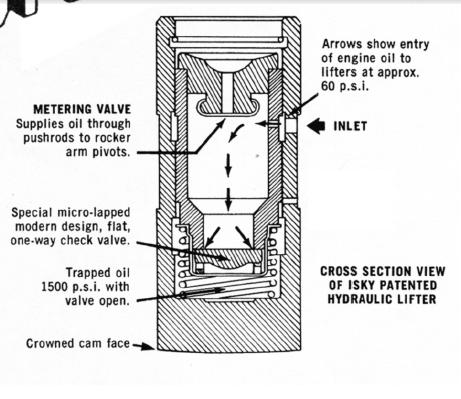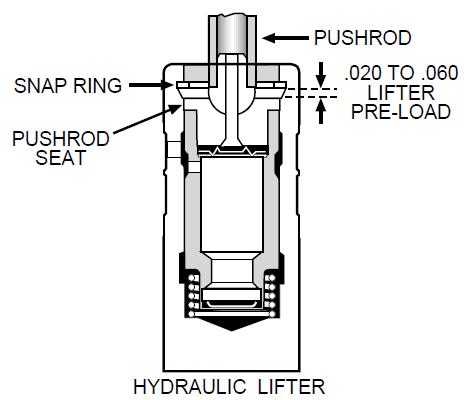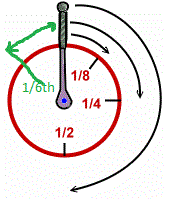EITHER, I don,t understand what your asking OR, this is a new one on me, so if you would care to go into the theoretical advantage of doing it that way please do so?
after all the idea of a hydraulic lifter is to allow pressurized oil to fill the area between the push rod seat in the lifter and the lifter body with oil to take up the slack in the valve train to provide a variable thickness or clearance cushion in the valve train as the dimensions and loads change and still maintain a low noise level and low maintenance.the thread pitch on the rocker studs and rocker ratio can be roughly calculated to give the rocker ball movement or distance displaced per degree or rotation and the distance the push rod seat can move above the lifter body it sits inside above the space that fills with oil is a known distance, so theres generally about 1.5 to 2 full turns before the push rod seat will be forced against the lifter body during any rocker nut adjustment.
if you adjust the hydraulic lifter's floating seat so it travels the max distance, with the minimal 1/4-1/2 turn preload setting,past the point it just stops clicking at idle, it tends to displace the maximum oil volume thru the push rod up to the rockers and thats what I generally advise, a 3/4-1 full turn setting restricts oil flow and reduces valve spring and rocker cooling and lubrication, this tends to reduce durability.
keep in mind the difference in lift transferred to the valve is minor , but the difference in long term durability seems noticeable to me under high stress conditions
valve springs that are not sufficiently oil cooled rapidly loose tension
endurance race engines frequently add additional valve spring oil coolers
READ LINK
viewtopic.php?f=52&t=6491&p=20679&hilit=valve+spring+cooling#p20679
one little known bit of engine trivia, the thread pitch on the rocker studs is a known value, and therefore you can use that info to get a close approximate lash clearance.
THAT INFO IS GOOD TO KNOW WITH SOLID LIFTERS
ok, HOW you ask?
if the rocker studs have a common NF thread theres a pitch or number of threads per inch, now obviously youll need to carefully verify what the thread pitch, and the clearances are with a feeler gauge on your engine, while its not running and take into account the rocker ratio but lets assume
3/8" 24 Threads Per Inch
7/16" 20 Threads Per Inch
obviously use of a different rocker ratio or thread pitch would cause a different amount of adjustment but the concept could be used once carefully checked out and you had some practice
Threads per Inch Distance
per 1/4 of a Full Turn
24 .0104
28 .0089
32 .0078
36 .0068
40 .0063
many Chevy rocker studs use a thread pitch of about .040 thousands per turn so once your very familiar with your solid lifter engines needs and the cam lash clearance you need and once you verify the pitch rate of the threads you can adjust solids surprisingly close to correctly by running them in till they quit clicking, then OUT about 1/3-1/2 a turn to get the correct lash rather than IN like on a hydraulic lifter to add pre-load,naturally you'll need to verify with a feeler gauge
related info
viewtopic.php?f=52&t=10158&p=39971&hilit=adjusting+rocker#p39971
viewtopic.php?f=52&t=196



